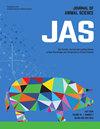189 Selection for moderate or high growth Angus-derived steer calves and their effects on feed intake and performance metrics during a 70-day feed intake period
IF 2.9
2区 农林科学
Q1 AGRICULTURE, DAIRY & ANIMAL SCIENCE
引用次数: 0
Abstract
Improvement in feed efficiency can improve beef cattle production’s sustainability. Measurements such as residual feed intake (RFI) or residual average daily gain (RADG) are used to assess feed efficiency of an animal. The objective of this study was to determine the effects of selection of growth phenotypes has on post-weaning feed intake, performance, and feed efficiency. The sires of 239 steers were selected for moderate growth (MG; top 75th percentile) or high growth (HG; Top 1st percentile) potential. Calves were produced at the Range Cow Research Center South (Spring) and North (Fall) Units from 2022 to 2023 (n = 4 seasons) to be preconditioned for 60 d. Steers were transported to Willard Sparks Beef Research Center for an individual feed intake trial following the preconditioning phase. Calves were adapted to a high concentrate diet over 28 d and then moved to the individual intake facility (Insentec feeding system, Hokofarm Group, Marknesse, Netherlands) for training, followed by a 70-d intake assessment. Animals were randomly assigned to pens containing individual feed intake monitoring systems (6 bunks/pen; 5 animals/bunk). Once trained, animals were transitioned to the finishing diet, which signaled the first day of the intake trial. Body weights were collected on d 0, 14, 28, 42, 56, and 70 during the 70-d individual feed intake trial. Metabolic body weight and average daily gain (ADG) for each individual steer was used for RFI and RADG determination by regressing body weight (BW) on day of BW collections using the Proc REG procedure in SAS. Residual Feed Intake and RADG calculations were determined by the difference in observed values and predicted values. Proc MIXED procedure in SAS was used for continuous data, and pen served as the random effect. Moderate growth steers in the Spring 2022, Fall 2022, Spring 2023, and Fall 2023 seasons dry matter intake were 1.36, 1.14, 1.24, and 1.15 kg, respectively (P ≤ 0.01; Table 1), less than HG steers. Feed efficiencies (P ≥ 0.19) did not differ between HG or MG phenotype steers for any of the feeding groups. Moderate growth phenotype steers in Spring 2022 and 2023 tended to have a lower RFI (-0.18 and -0.44 kg, respectively; P ≤ 0.07) than the HG phenotype (0.47 and 0.22 kg, respectively), whereas in Fall 2022 and 2023, growth phenotypes did not differ (P ≤ 0.68). Residual average daily gains (P ≥ 0.11) did not differ between MG and HG within each season. Steers with the MG phenotype consumed less feed resources with lower RFI, but performance and feed efficiency during the feed intake trial did not differ. The improved RFI without impacting performance may indicate MG cattle can provide for more sustainable beef production, but more research is needed.189中高生长安格斯犊牛的选择及其对70 d采食量和生产性能指标的影响
饲料效率的提高可以提高肉牛生产的可持续性。剩余采食量(RFI)或剩余平均日增重(RADG)等测量方法用于评估动物的饲料效率。本研究的目的是确定生长表型选择对断奶后采食量、生产性能和饲料效率的影响。选取239头牛为中等生长型(MG;前75百分位)或高增长(HG;前1百分位)潜力。小牛于2022年至2023年(n = 4个季节)在牧场奶牛研究中心南(春季)和北(秋季)单元生产,并进行60 d的预调节。在预调节阶段后,将阉牛运往威拉德斯巴克斯牛肉研究中心进行个体采食量试验。犊牛在28 d内适应高精料日粮,然后转移到单独的采食设施(荷兰Marknesse hoofarm Group的Insentec饲喂系统)进行训练,随后进行70 d的采食评估。动物随机分配到有单独采食量监测系统的圈内(6个栏/圈;5动物/双层)。一旦训练完毕,动物们就会过渡到终期饮食,这标志着摄入试验的第一天。分别在70 d采食量试验的第0、14、28、42、56和70天采集体重。采用SAS的Proc REG程序,对采集日体重(BW)进行回归,以每头牛的代谢体重和平均日增重(ADG)进行RFI和RADG测定。根据观测值与预测值的差值确定剩余采食量和RADG的计算。连续数据采用SAS软件中的Proc MIXED程序,随机效应采用pen。2022年春、2022年秋、2023年春和2023年秋4个季节中速生长阉牛干物质采食量分别为1.36、1.14、1.24和1.15 kg (P≤0.01;表1),小于HG舵手。任何饲喂组的饲料效率(P≥0.19)在HG和MG表型组之间没有差异。2022年春季和2023年春季的中等生长表型阉牛往往具有较低的RFI(分别为-0.18和-0.44 kg;P≤0.07)高于HG表型(分别为0.47和0.22 kg),而在2022年和2023年秋季,生长表型差异无显著性(P≤0.68)。各季节MG和HG的剩余平均日增重(P≥0.11)无显著差异。MG表型的牛消耗的饲料资源较少,RFI较低,但采食量试验期间的生产性能和饲料效率没有差异。在不影响生产性能的情况下,改进的RFI可能表明MG牛可以提供更可持续的牛肉生产,但需要更多的研究。
本文章由计算机程序翻译,如有差异,请以英文原文为准。
求助全文
约1分钟内获得全文
求助全文
来源期刊

Journal of animal science
农林科学-奶制品与动物科学
CiteScore
4.80
自引率
12.10%
发文量
1589
审稿时长
3 months
期刊介绍:
The Journal of Animal Science (JAS) is the premier journal for animal science and serves as the leading source of new knowledge and perspective in this area. JAS publishes more than 500 fully reviewed research articles, invited reviews, technical notes, and letters to the editor each year.
Articles published in JAS encompass a broad range of research topics in animal production and fundamental aspects of genetics, nutrition, physiology, and preparation and utilization of animal products. Articles typically report research with beef cattle, companion animals, goats, horses, pigs, and sheep; however, studies involving other farm animals, aquatic and wildlife species, and laboratory animal species that address fundamental questions related to livestock and companion animal biology will be considered for publication.
 求助内容:
求助内容: 应助结果提醒方式:
应助结果提醒方式:


